#morchella importuna
Photo
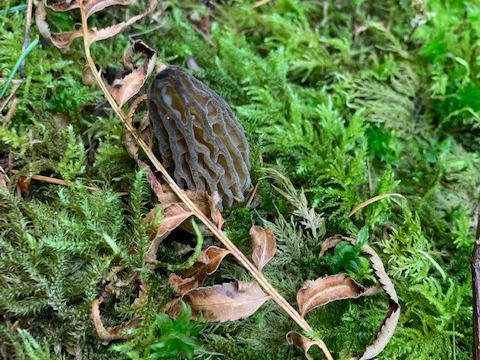
04/05/2023 The Blue Haired Girlfriend spotted a couple morels while we were walking down to the mailbox. Delicious! We've never seen morels here before.
Every year, in spring and autumn, when the light comes through the rain in a particular way, we go through a process foragers sometimes call "getting your mushroom eyes." At first you look at pieces of the forest one after another: the shadow of a likely tree, a mossy hollow, a fallen log, a pile of rotting leaves. Mushrooms could be in this place, or that one, and you focus on each possibility one at a time, switch between them with a sort of internal click. But as the rains continue and the world greens, we start to read the forest as a whole story, instead of sounding out each individual shadow and clump of moss. There's a trick to it that has to be relearned each season, a porousness, a way of looking at the world and letting it flow through you and feeling the underlying currents and patterns.
Until one day you are walking in the woods and there are mushrooms everywhere and it doesn’t seem possible you didn’t see them before. Like you've gone through a hidden doorway into a different world, stranger and truer than the old one.
The thing that is most like getting your mushroom eyes is falling in love. You meet someone. A musician: you talk about synthesizers and phrygian mode. You look at the moon together when you are sleepless thousands of kilometers apart. You've never been good at conversation, but she listens to everyone - waiters and tow truck drivers and delivery people - and you learn that everyone has a story so beautiful that listening to them tell it feels like wings opening inside your ribcage. At first the glimpses of the other world are piecemeal, clicking into and out of focus - like maybe you hear a synthesizer in grocery store background music, and you tell your friends, "hey, you know, my girlfriend is a musician," and they smile tolerantly. (It is not the first time they have heard this.)
Until one day you realize you can feel the phase of the moon without looking at it, the mode of a song is as clear as its lyrics, and that when you talk to a stranger you can see a soft light in them now, like a lantern through stained glass. It doesn’t seem possible that you didn’t see these things before, somehow. You have come through the door of her, to a better world, vaster and stranger and truer.
We enjoy cooking, but I think more than the occasional leaf or mushroom for the kitchen, the thing we love about foraging is to love the world, together.
#daily#morel#morchella importuna#mushroom#mushroom eyes#rank sentimentality#the blue haired girlfriend#posts i think are a good idea when I've had two hours' sleep#i have not been posting for three years and I am a little drunk on how many words there are in the world
223 notes
·
View notes
Text
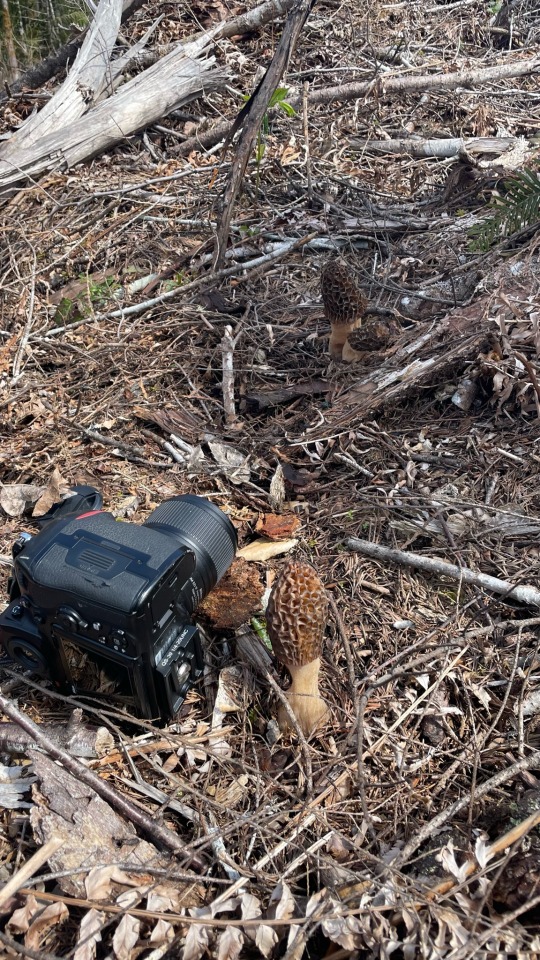
I got bored finding verpas 🤷♀️
60 notes
·
View notes
Photo


My Backyard Morels
Morchella importuna
Western Washington, April 26 2023
Photos Mary Howerton
#morels#mushrooms#fungi#mycology#foraging#nature#garden#photography#nature photography#original photography#photographers on tumblr#tumblr photographers#lensblr#pnw#morchella#morchella importuna#aesthetic
50 notes
·
View notes
Text


#Morchella importuna#oil pastel#oil pastels#fungi#mushroom#mushroom art#hiddenstashart.Etsy.com#morel#morels#morel art#art for sale
2 notes
·
View notes
Text
How to Identify Morels
Originally posted at my website at https://rebeccalexa.com/how-to-identify-morels/ - Click here to learn more about the How to Identify article series.
Name: True morels (Morchella spp.)
Range and typical habitat(s): Widespread throughout temperate North America, Europe, New Zealand and Australia; less commonly reported in South America, Asia, and coastal Africa. Morels are commonly found in wooded areas, and many species grow primarily on soil; these may have symbiotic (though not necessarily mycorrhizal) relationships with trees and other plants. Other morels, such as M. importuna, are saprotrophs that happily colonize dead wood, to include mulch used in landscaping. At least one, the white morel M. rufobrunnea, may be capable of both lifestyles. Morels are exceptionally difficult to cultivate, and no large-scale cultivation method has been developed as of this writing.
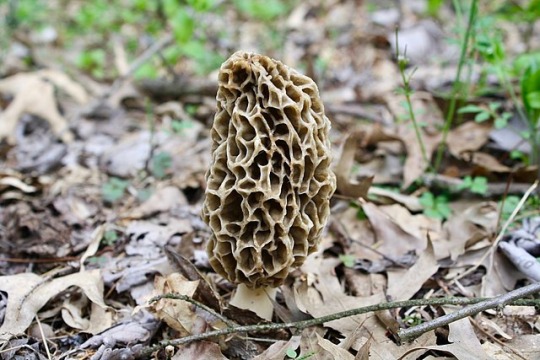
M. americana
Both deciduous and conifer forests may be homes to morels; yellow morels tend toward deciduous, while conifer forests are more likely to feature black morels. A wide variety of tree genera may be associated with morels include but are not limited to Pseudotsuga, Pinus, Abies, Quercus, Fraxinus, Alnus, and Castanea.
However, the half-free morels–M. punctipes (seen below), M. populiphila, and M. semilibera–may have a small space between the bottom edge of the cap and the stipe. The cap has a honeycombed appearance, with surfaces deeply pockmarked with cavities surrounded by brittle ridges that crumble into fragments when crushed. Colors vary, and morel species are often grouped together by cap color; black morels have a dark brown to black cap, while yellow and white morels are more tan to cream.

M. punctipes, cut in half to show hollow centers, and only the upper portion of the caps attached to the stipes. Photo by Chase G. Mayers, CCA-4.0
The stipe may be lightly textured, and is usually lighter in color than the cap, often white, cream, or pale yellow depending on species. Cutting a morel’s stipe open reveals that it is entirely hollow inside. A mature morel is generally around three to six inches high, though larger specimens have been found.

M. americana with the top removed, showing the hollow interior.
The stipe may be lightly textured, and is usually lighter in color than the cap, often white, cream, or pale yellow depending on species. Cutting a morel’s stipe open reveals that it is entirely hollow inside. A mature morel is generally around three to six inches high, though larger specimens have been found.
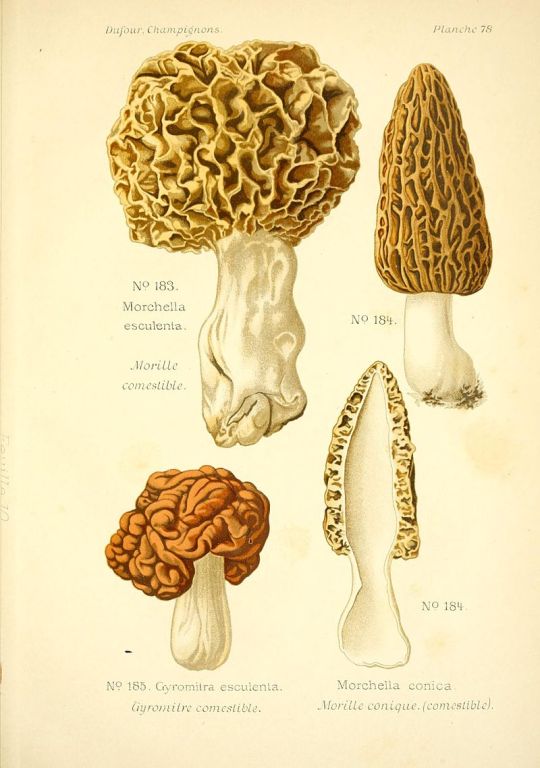
A vintage illustration shows three morels, to include one cut in half to display the hollow center; the mushroom in the lower left is a false morel (Gyromitra esculenta).
Other organisms it could be confused with and how to tell the difference: There are multiple groups of mushrooms that look similar enough to morels to cause confusion; given morels are a popular edible mushroom, consumption of some of these lookalikes has caused serious illness on numerous occasions.

V. bohemica; note that the bottom edge of the cap is not attached to the stipe, and that it has more of a wrinkled appearance than honeycombed. By NeoSporen, CCA-SA-3.0.
Members of the genus Verpa look similar to half-free morels in that the bottom edge of the cap is not attached to the stipe. However, when cut in half the half-free morels have more of the upper portion of the cap attached to the stipe; Verpas only have the very tip attached. Outwardly they do look quite similar to morels overall, often having a conical cap with a honeycombed texture; some may have less distinct cavities and a more “lumpy” appearance rather than honeycombed. The cap of the Verpa is generally smaller in proportion to the stipe than on mature morels. The stipes of young Verpas are full of soft, fluffy hyphae, but they become hollow like morels as they mature.
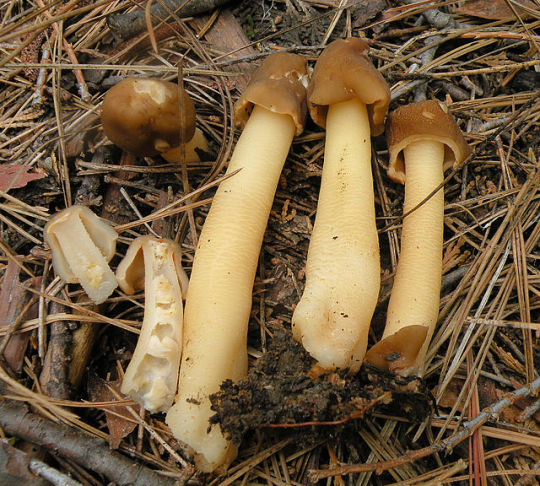
V. conica, showing one cut in half. Note that the cap is only attached to the stipe at the very top, and there is still some fungal hyphae tissue in the center of the stipe. Photo by Jeff Riedenauer (Tamsenite), CCA-SA-3.0.
Like morels, they are considered by some to be edible when thoroughly cooked. However, one study purports that V. bohemica is also toxic, having the same sort of toxins as the false morels I’ll discuss below. Some field guides recommend avoiding the other Verpa species as well due to potential inedibility. Both Verpas and morels fruit in spring, and may sometimes be found in the same area. As someone who would like to become an old, rather than bold, mushroom hunter, I recommend skipping the Verpas and sticking to the true morels, just in case.
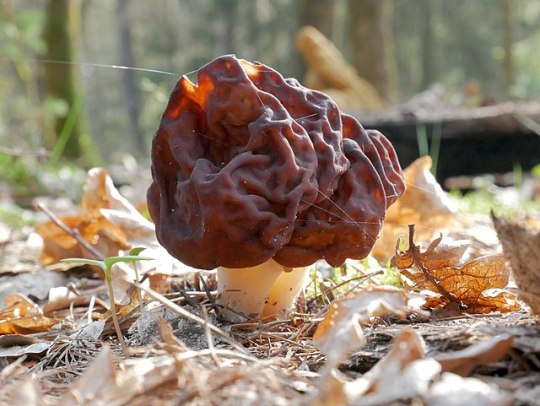
A false morel (Gyromitra spp.); notice that instead of looking like a cone made of honeycomb, it resembles a raisin or a brain on a stalk.
False morels, in the genus Gyromitra, are a more notorious morel lookalike. Several species contain significant levels of gyromitrin, a compound that when boiled or consumed hydrolizes into monomethylhydrazine, a chemical used in making rocket fuel. Consumption may cause gastrointestinal distress, neurological symptoms, kidney and liver failure, coma, and failure of the respiratory and circulatory systems. The most severe cases result in death within a week after consuming false morels. Some species have more gyromitrin than others, and it’s likely that the compound can build up over time in people who eat false morels on a regular basis. While there are purported methods used to reduce or remove gyromitrin from false morels, as a foraging instructor I do not recommend consuming any Gyromitra false morels due to the risk of severe illness.

G. californica. Note that the stipe is not completely hollow inside, but has several cavities divided by fungal tissue. Photo by Alan Rockefeller, CCA-SA-4.0.
So how do you tell the difference? Where true morels look like honeycombed cones, false morels look like brains, oversized raisins, or piles of worms. If you cut a true morel open the stipe will be completely hollow, but the interior of a false morel may have multiple smaller chambers or be completely solid. It is exceptionally important to make sure you get a sure identification on whatever species you are picking, as true and false morels fruit in spring, and sometimes in the same areas.

M. angusticeps
Anything else worth mentioning? Morels are definitely one of those mushrooms you want to cook thoroughly before eating, as raw or undercooked morels can cause gastrointestinal distress. Also, if you hang around mushroom foragers long enough, you’ll hear all sorts of advice–some of it conflicting–about when and where to find morels. It’s true that they fruit in spring, starting in lower elevations where it warms up sooner, and then higher elevations as spring temperatures continue to rise. South-facing slopes that warm up faster with sunlight may also see earlier fruiting. And, of course, places that burned or were logged in the last year or two may see a bumper crop of morels the following spring. Many patches of morel mycelium only last a few years, so the place you found morels one year may not fruit the next.
Beyond that, it’s best to study up on the species of morel that grow in your area. Find out what sorts of habitats they like, if they’re associated with any particular trees, whether they are responsive to burns and other disturbances, and whether there are any toxic look-alikes that grow nearby.
Further reading:
The Great Morel
Mushroom Expert: Morchellaceae
Tom Volk’s Morel Page
Mushroom Appreciation: Morel Mushroom
Did you enjoy this post? Consider taking one of my online foraging and natural history classes, checking out my other articles, or picking up a paperback or ebook I’ve written! You can even buy me a coffee here!
#morels#mushrooms#fungi#fungus#mushroom hunting#mushroom foraging#foraging#wild foods#wild mushrooms#mycology#biology#nature#outdoors#forest#poisonous mushrooms#edible mushrooms
173 notes
·
View notes
Text

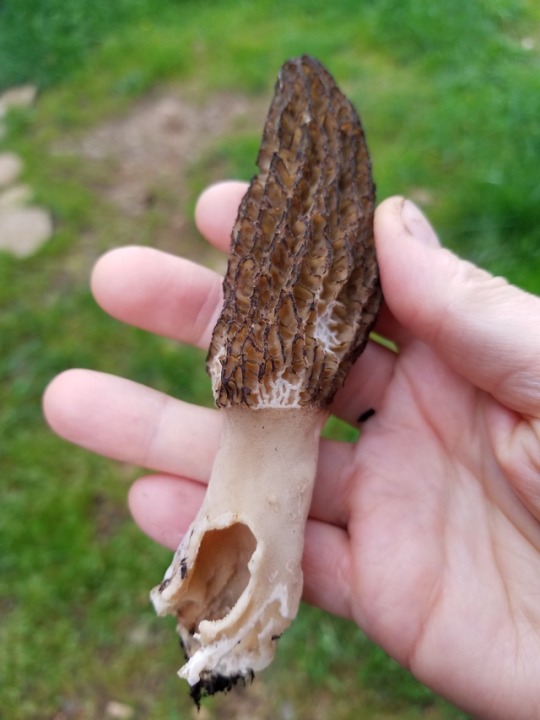
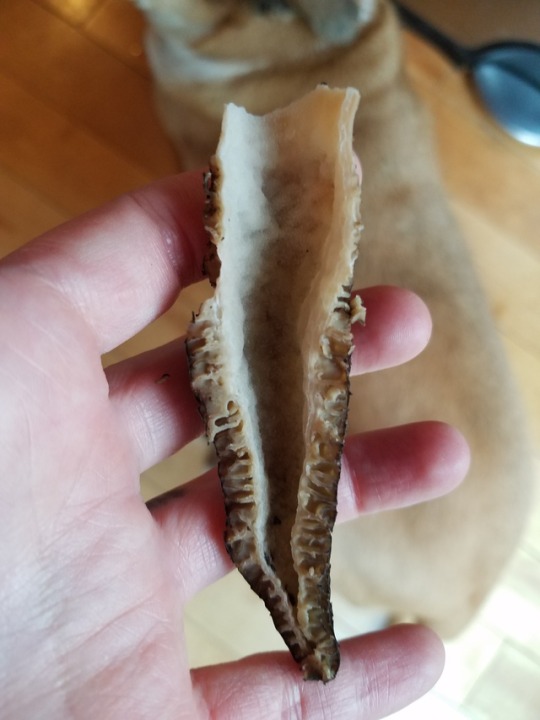
Morchella species (Morel), possibly importuna. Founds dozens of these on the east side landscaped area with the Cornus tree, and a few by the blueberry bushes.
1 note
·
View note
Photo
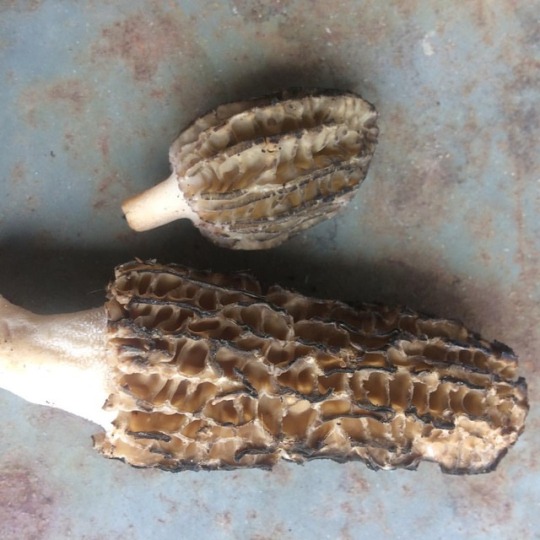
Morchella importuna // everyone lusts for these spores ⚡️⚡️⚡️ (at Oregon)
0 notes
